Japandi is a unique interior design style that has caught the eye of many. It combines traditional Japanese and Scandinavian aesthetics. This blend has been around for centuries, starting in the 19th century when Scandinavian designers fell in love with Japanese craftsmanship.
Now, Japandi is very popular in the United States. People love it for its focus on quality, sustainability, and creating calm, simple living spaces.
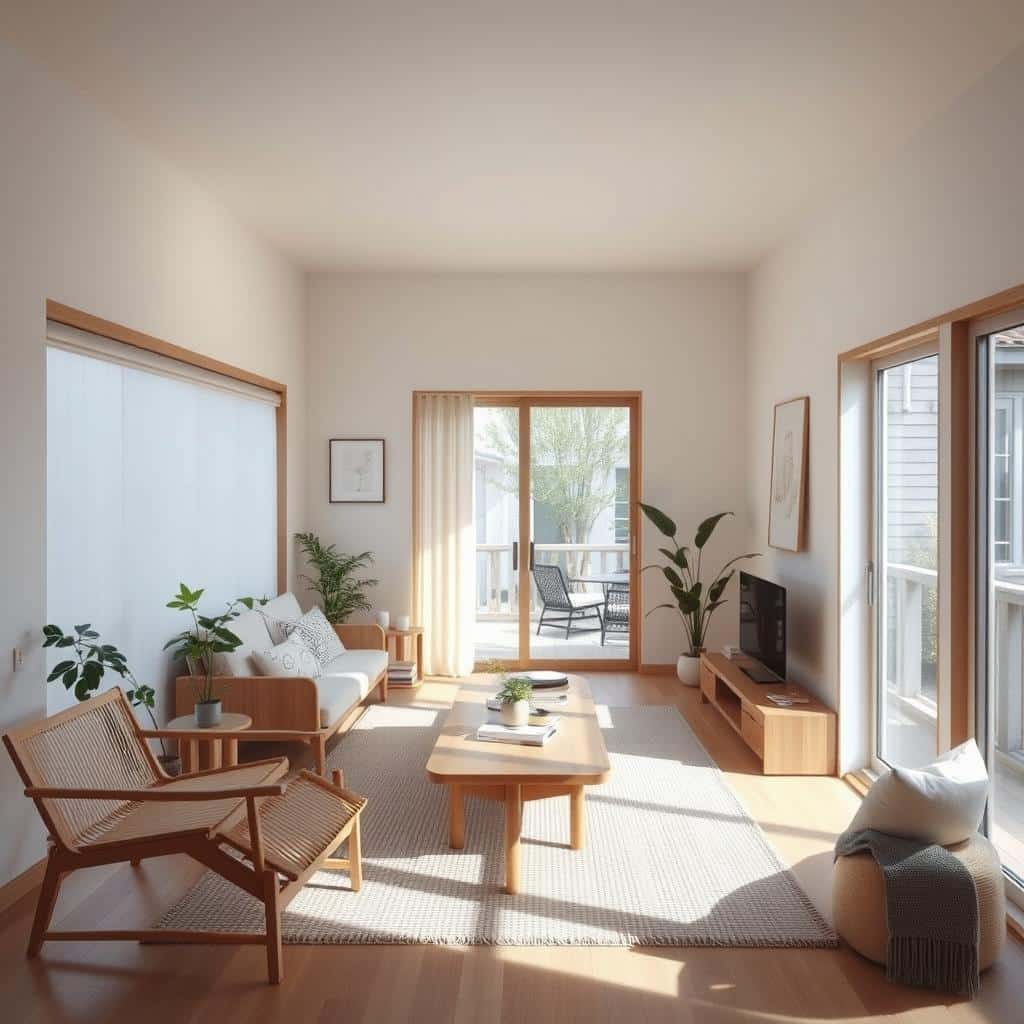
The Japandi design philosophy values simplicity, natural elements, and comfort. It uses neutral colors, high-quality natural materials, and lots of greenery. This style mixes Scandinavian design’s clean lines and functionality with Japanese design’s warmth and beauty.
What is Japandi Style?
Japandi style is a mix of Japanese and Scandinavian design. It combines the clean lines of Scandinavia with Japan’s warm elegance. This style loves simplicity, natural materials, and focuses on function and quality.
Understanding the Fusion of Japanese and Scandinavian Aesthetics
The Japandi style takes from both Japanese and Scandinavian design. It uses the Japanese idea of wabi-sabi, which finds beauty in imperfection. It also adds the Scandinavian concept of hygge, which is about making a cozy home. This blend creates a calm, simple look that feels grounding.
The Principles of Simplicity, Nature, and Comfort in Japandi Design
- It uses light colors and natural materials like wood and bamboo. This makes spaces calm and inviting.
- It values minimalism, function, and quality. This means choosing a few, but better, items.
- It brings the outdoors in with plants and natural light. This adds a fresh feel to rooms.
- It uses textures and fabrics to add warmth. Think of soft linen and velvet.
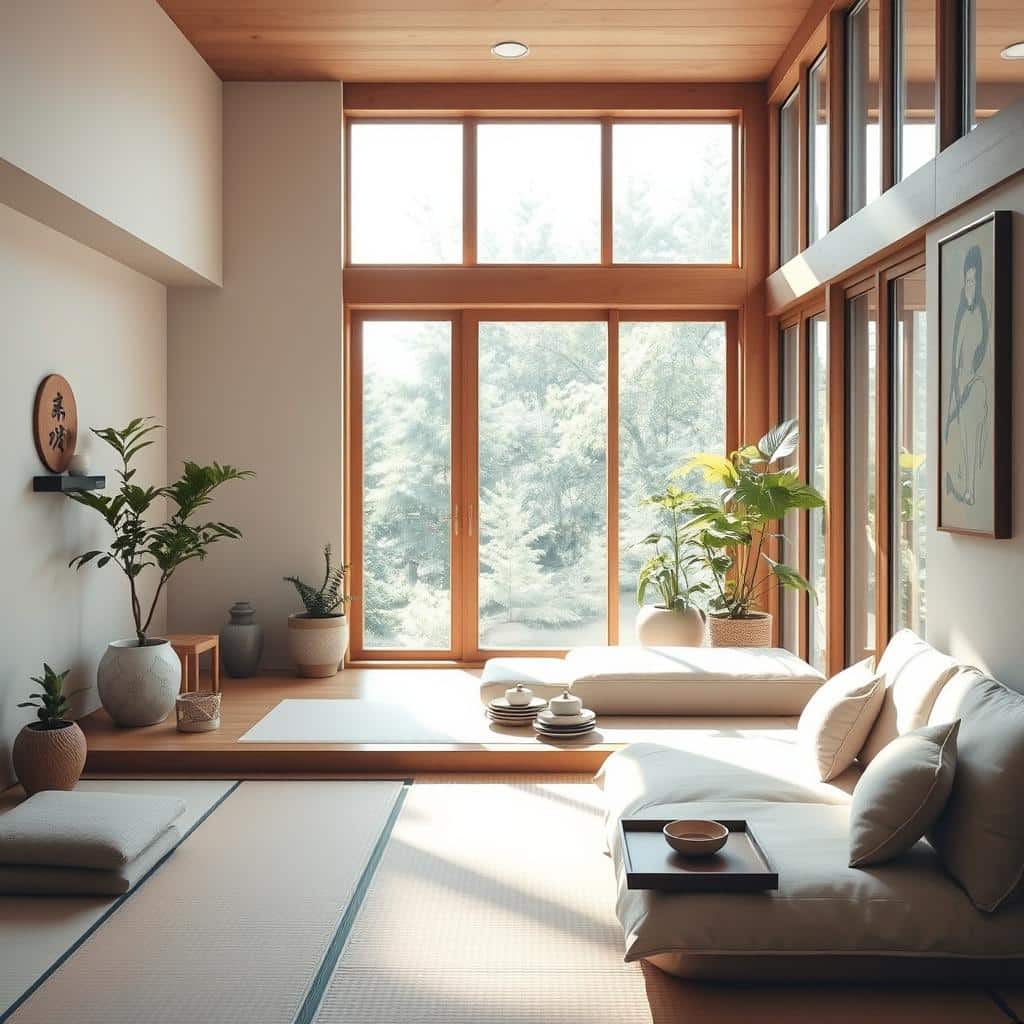
Japandy design is becoming more popular in interior design. It offers a calm, simple look with a cozy, functional twist.
History and Origins of Japandi Interior Design
The Japandi interior design started in the 19th century. Scandinavian designers were drawn to Japan’s unique craftsmanship and style. This mix of styles created the Japandi trend we know today.
Scandinavian Designers’ Fascination with Japanese Craftsmanship
In the late 19th century, Scandinavian designers traveled to Japan. They were amazed by Japan’s artistry and focus on detail. They loved Japan’s minimalism and use of natural materials.
This love for Japanese design led them to mix it with their own. They created a unique blend of Scandinavian and Japanese styles.
The Evolution of Japandi from the 19th Century
As time went on, Scandinavian and Japanese design kept evolving. In the 20th century, designers from both sides worked together. They made the Japandi style even more special.
The Japandi style interior design combines Scandinavian clean lines with Japanese simplicity. The term “Japandi” might be new, but its roots go back to the late 1800s.
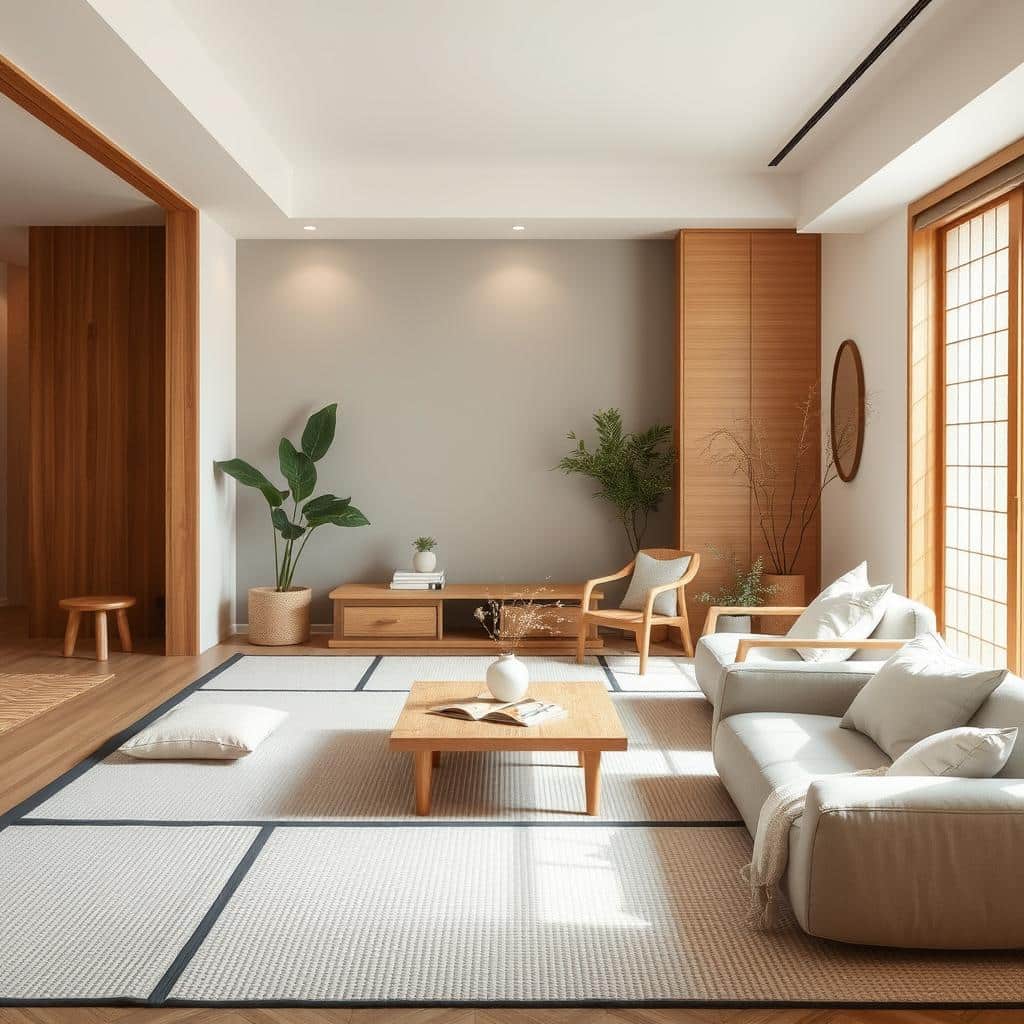
Today, Japandi design is popular for its calm and creative spaces. It mixes Scandinavian and Japanese ideas. This mix brings warmth, function, and connection to our homes.
Key Elements of Japandi Interior Design
Interior design Japandi combines Scandinavian minimalism with Japanese simplicity. It creates a calm and elegant living space. This blend celebrates the beauty of imperfection.
Neutral Color Palettes and Natural Materials
Japandi interiors use a neutral color scheme. You’ll see warm neutrals like beige and cool tones like gray and blue. These colors are paired with natural materials like wood and bamboo.
High-quality, sustainable materials are key in Japandi design. Handcrafted items from terracotta and glass add authenticity and depth.
Minimalism, Functionality, and Quality Craftsmanship
Minimalism is central to Japandi design. It focuses on clean lines and open spaces. Quality craftsmanship is also important, with a preference for handmade items.
Ceramics are a big part of Japandi interiors. They add texture and beauty. Natural elements like plants enhance the serene Japandi ambiance.
By mixing Scandinavian and Japanese design, Japandi interiors offer a timeless, sustainable space. They promote mindfulness and well-being.
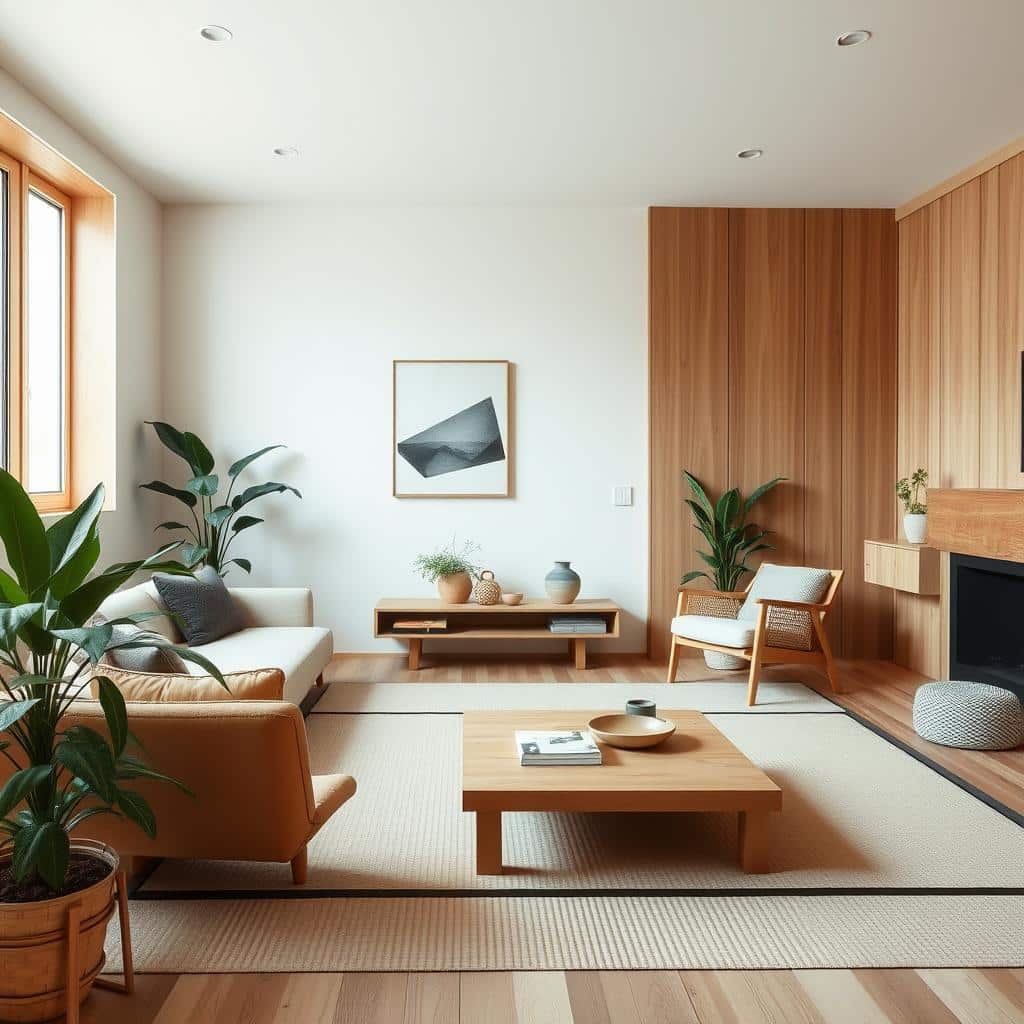
Incorporating Wabi-Sabi and Hygge into Japandi Spaces
Japandi design combines Japanese wabi-sabi and Scandinavian hygge. Wabi-sabi loves the beauty of imperfection. Hygge is about cozy comfort. Together, they use natural materials and focus on minimalism.
Wabi-sabi values natural imperfections. Japandi spaces use handcrafted items and raw wood. This creates a genuine and peaceful vibe.
Hygge adds warmth to Japandi spaces. It uses soft textures and warm lights. This makes spaces cozy and inviting.
Wabi-sabi and hygge together make Japandi spaces special. They offer a calm and mindful living area. This mix of Japanese and Scandinavian styles creates a peaceful home.
| Wabi-Sabi | Hygge |
|---|---|
| Embraces imperfection and impermanence | Promotes comfort and coziness |
| Celebrates natural textures and flaws | Emphasizes soft fabrics and warm lighting |
| Fosters a sense of mindfulness and introspection | Encourages a feeling of contentment and well-being |
| Originates from Japanese aesthetic principles | Rooted in Scandinavian design and lifestyle |
Japandi design blends wabi-sabi and hygge. It creates a calm and cozy space. This mix of Japanese and Scandinavian styles offers a timeless design approach.
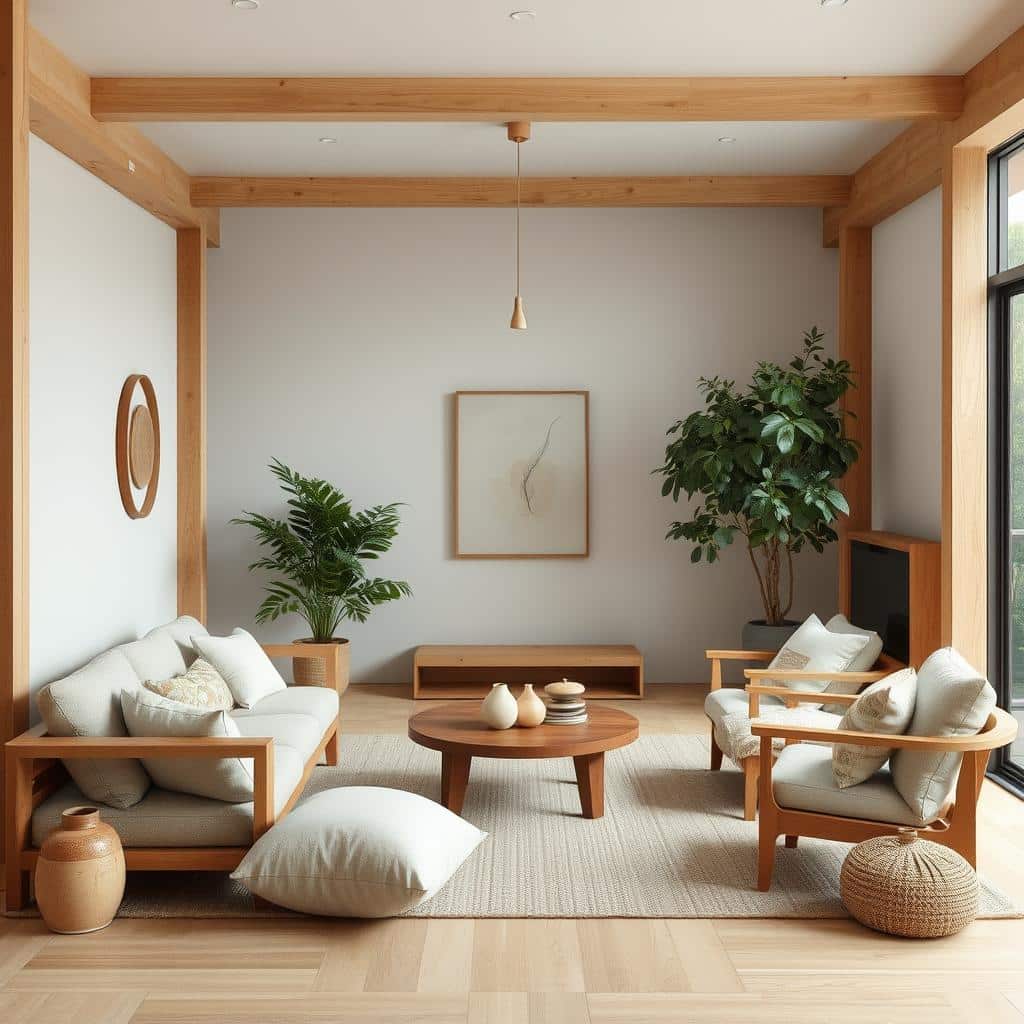
Japandi Style in Living Rooms
Japandi design blends Japanese and Scandinavian styles for a calm, welcoming living area. Choosing the right furniture and layout brings peace to the room.
Furniture Choices and Layout for a Serene Living Space
Neutral-colored sofas, wooden coffee tables, and simple lights create a cozy feel. The room should have open spaces for a smooth flow. Choose furniture that’s both stylish and practical, like sleek side tables or modular seats.
Balancing Textures and Incorporating Nature
Japandi style loves mixing textures. Use wool, linen, and wood to make the room interesting. Add plants or natural elements like driftwood to bring in nature. This mix of textures and nature makes the room peaceful and beautiful.
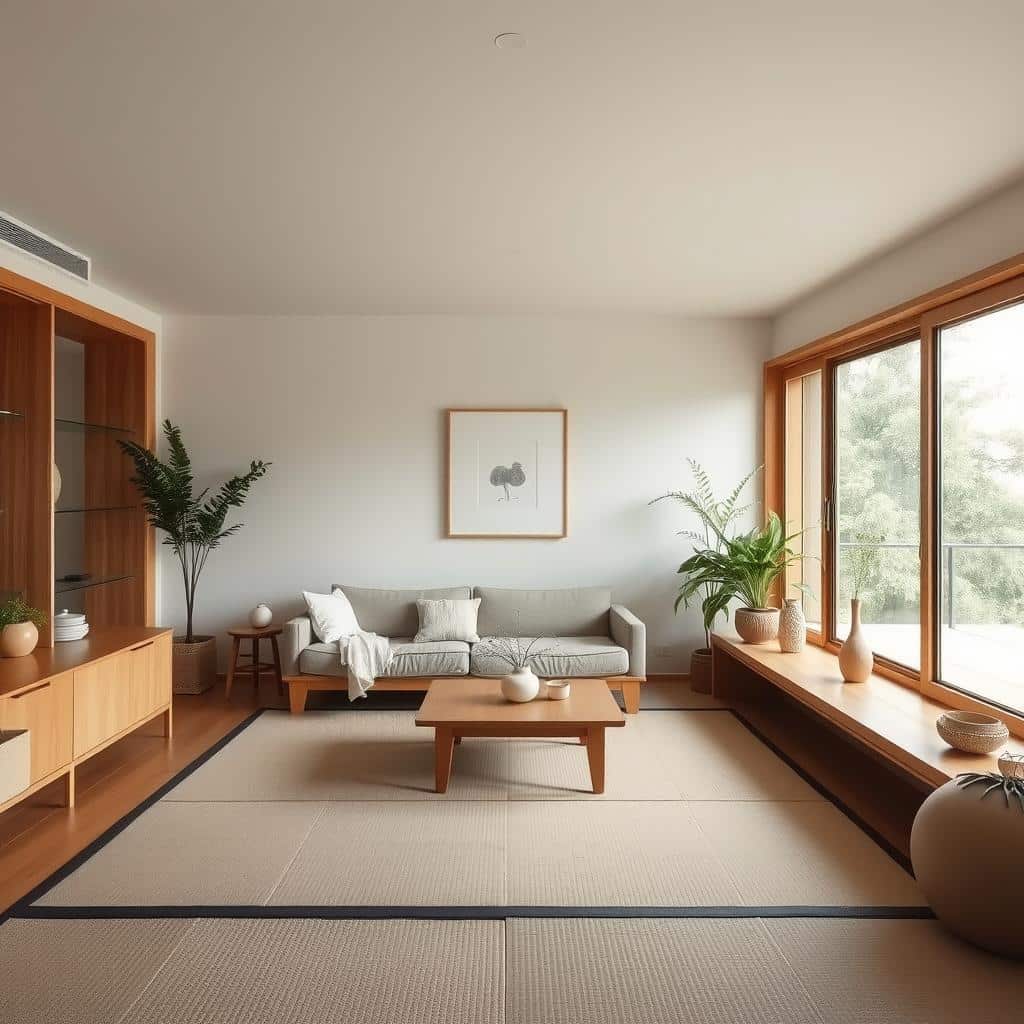
Japandi living rooms are all about simplicity, usefulness, and nature. With the right furniture, layout, and textures, your room can become a peaceful retreat. It shows the timeless beauty of Japandi design.
Japandi Bedrooms: Tranquil Retreats
Japandi bedrooms are peaceful havens. They blend simplicity, natural materials, and comfort. This mix creates a calm and restful place. Neutral colors, minimal decor, and natural elements like wood and plants add to the Japandi feel.
The Japandi bedroom often has a calming color scheme. Think whites, beiges, and grays. Earthy tones like sage green and dusty blue bring warmth. Furniture is simple and made from wood or bamboo, fitting the Japandi interior design.
Lighting is key in a Japandi bedroom. A mix of light types creates a cozy feel. Wood is a big part of the warm, inviting Japandi bedroom vibe. Keeping things simple helps keep the space calm and clutter-free.
- Neutral color palettes with earthy accents
- Minimalist furniture made from natural materials
- Balanced lighting featuring ambient, task, and accent sources
- Emphasis on natural materials, particularlly wood
- Embrace the “one in, one out” principle to maintain a clutter-free space
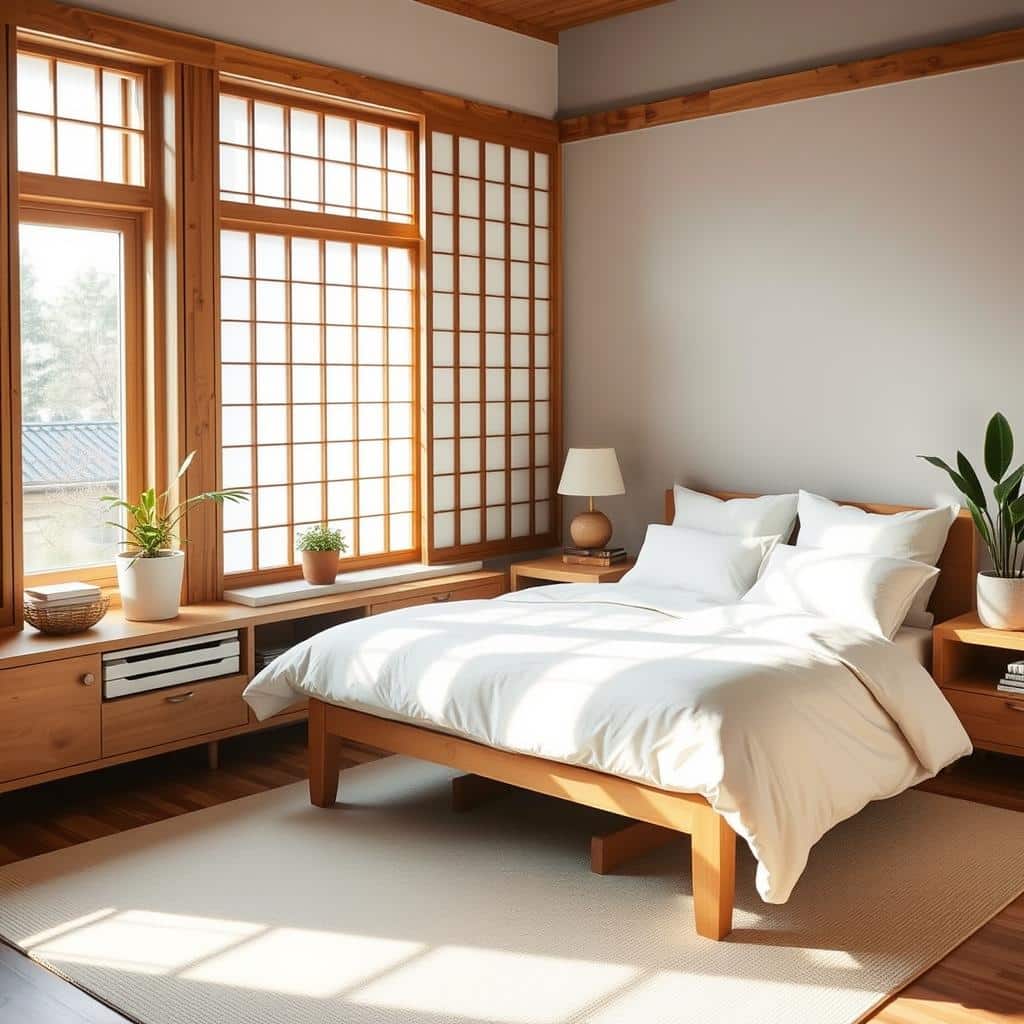
Japandi bedrooms mix Japanese simplicity with Scandinavian coziness. They offer a peaceful and refreshing space. It’s perfect for those who want a calm and harmonious place to live.
Japandi Bathrooms: Zen-Inspired Sanctuaries
The Japandi bathroom combines Japanese and Scandinavian styles. It creates a peaceful and welcoming space. Natural materials and clean lines bring a sense of calm and well-being.
Embracing Natural Materials and Clean Lines
Japandi bathrooms use wood, stone, and bamboo. These materials add warmth and connect us to nature. The simple lines and fixtures make the space calm and balanced.
Creating a Spa-Like Atmosphere
Japandi bathrooms aim to be Zen retreats. They use neutral colors like white, beige, and gray. Soft lighting, from natural and fixtures, adds to the spa feel.
Following Japandi design, bathrooms become calm sanctuaries. They offer a peaceful escape from the world outside.
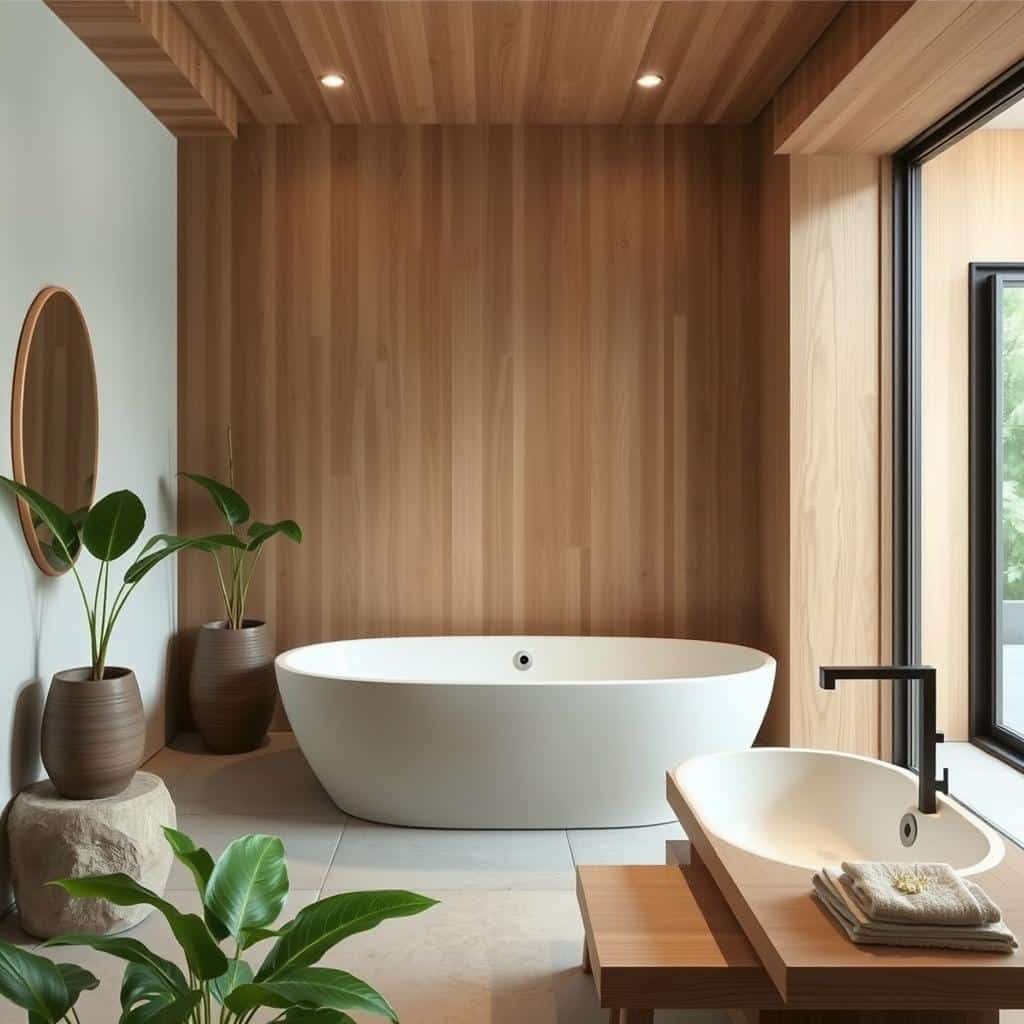
Japandi Kitchens: Functional and Minimalist
The Japandi kitchen combines Japanese and Scandinavian styles. It’s a space that looks great and works well. It loves natural materials, open areas, and mixing looks with function.
Incorporating Wood and Stone for Warmth
Japandi kitchens use wood and stone for warmth and realness. Wooden cabinets, stone counters, and bamboo add a touchable feel. These choices make the kitchen feel timeless and handmade.
Emphasizing Open Spaces and Natural Light
Japandi design focuses on open spaces and light. Kitchens are laid out for easy movement and function. Big windows and skylights bring in lots of natural light, making the space feel calm and open.
| Feature | Japandi Kitchen Approach |
|---|---|
| Color Palette | Neutral tones, including whites, grays, and soft earthy hues, create a calming and cohesive atmosphere. |
| Cabinetry | Minimalist design with clean fronts and simple hardware, often featuring natural wood or light-colored finishes. |
| Countertops | Durable materials like stone, such as marble or soapstone, contribute to the overall Japandi aesthetic. |
| Lighting | Streamlined fixtures and the strategic placement of natural light sources emphasize the minimalist and functional approach. |
| Accessories | Carefully curated decor items, including plants, ceramics, and natural textiles, add depth and personality to the space. |
By following Japandi design, homeowners can make a kitchen that’s both beautiful and practical. It combines the best of Japanese and Scandinavian styles.

Japandi Decor and Accessories
The Japandi interior design style focuses on simplicity, natural elements, and function. It shines in decor and accessories with minimalist art, sculptural pieces, greenery, and natural textures.
Minimalist Art and Sculptural Pieces
Japandi decor often includes minimalist artwork and sculptural accents. These add interest without overwhelming the space. They are usually neutral in color and have clean, simple shapes.
Artwork might be abstract paintings, line drawings, or minimalist sculptures. They draw the eye without disrupting the room’s calm atmosphere.
Incorporating Greenery and Natural Textures
Elements of nature are key to Japandi style. Potted plants, fresh flowers, and greenery add tranquility and balance. Textural accents like woven baskets and natural fiber rugs connect us to nature.
| Japandi Decor Elements | Examples |
|---|---|
| Minimalist Art | Abstract paintings, line drawings, geometric sculptures |
| Sculptural Pieces | Organic-shaped vases, minimalist candle holders, abstract ceramics |
| Greenery | Potted plants, fresh floral arrangements, hanging plants |
| Natural Textures | Woven baskets, rattan furniture, natural fiber rugs, linen textiles |
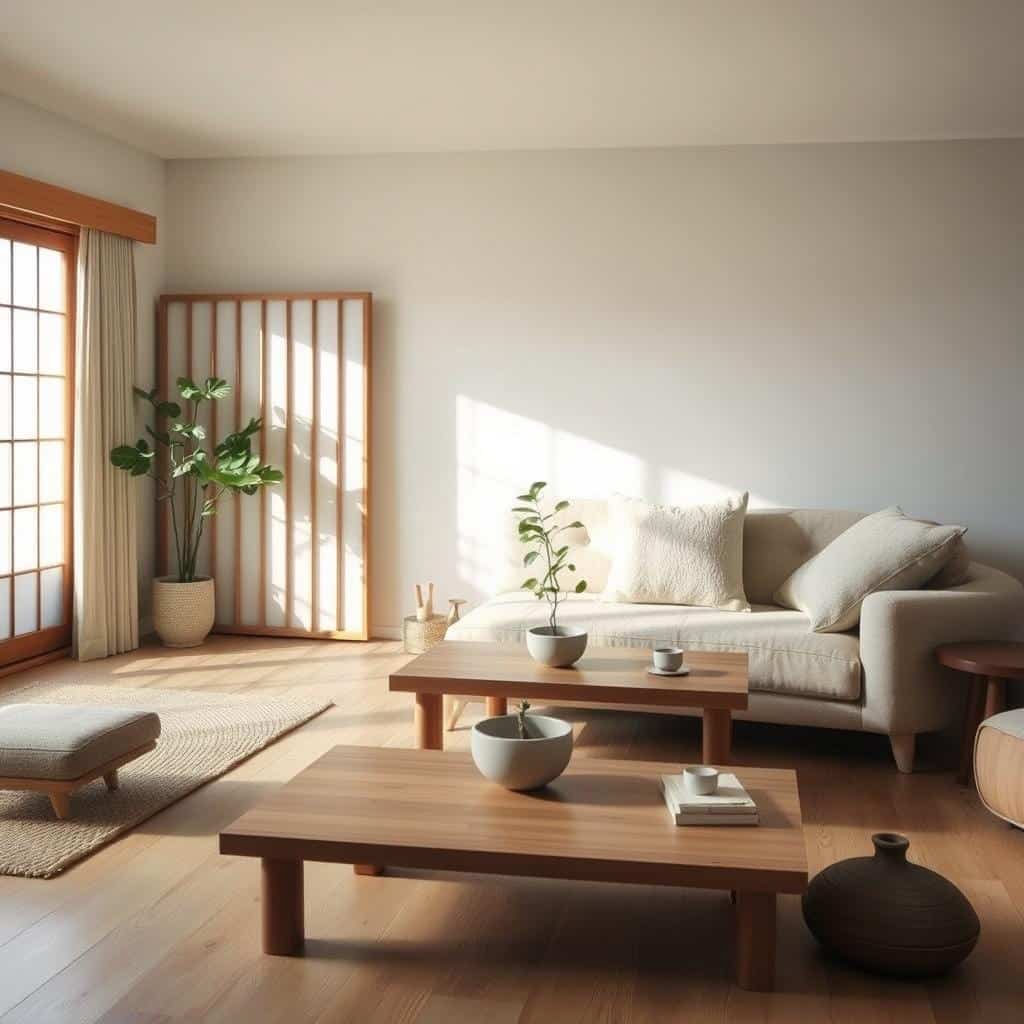
Choosing Japandi-inspired decor and accessories creates a serene space. It reflects simplicity, nature, and function, defining this unique style.
Japandi in Interior Design Trends
The Japandi design style is becoming more popular in the United States. It combines Japanese and Scandinavian styles, focusing on minimalism and sustainability. People want homes that are both eco-friendly and timeless, making Japandi a top choice.
Japandi interiors feature low-height furniture with clean lines. The colors are warm neutrals and soft tones, like cream and muted greens. This creates a calm and balanced look.
Quality is key in Japandi design. Handcrafted furniture is preferred for its durability and elegance. Adding natural elements like plants and bamboo brings a sense of peace. Dining rooms will use materials like cotton and bamboo, showing a commitment to the environment.
| Japandi Interior Design Trends | Key Characteristics |
|---|---|
| Furniture | Low-height, simple yet precise lines |
| Color Palette | Warm neutrals and muted tones (cream, beige, muted greens, blues) |
| Materials | Natural, sustainable (wood, bamboo, cotton, wool) |
| Decor Emphasis | Quality over quantity, handcrafted, timeless elegance |
| Natural Elements | Plants, driftwood, bamboo |
Japandi style is set to keep growing in popularity. It meets the need for simple, green, and natural homes in the United States and worldwide.
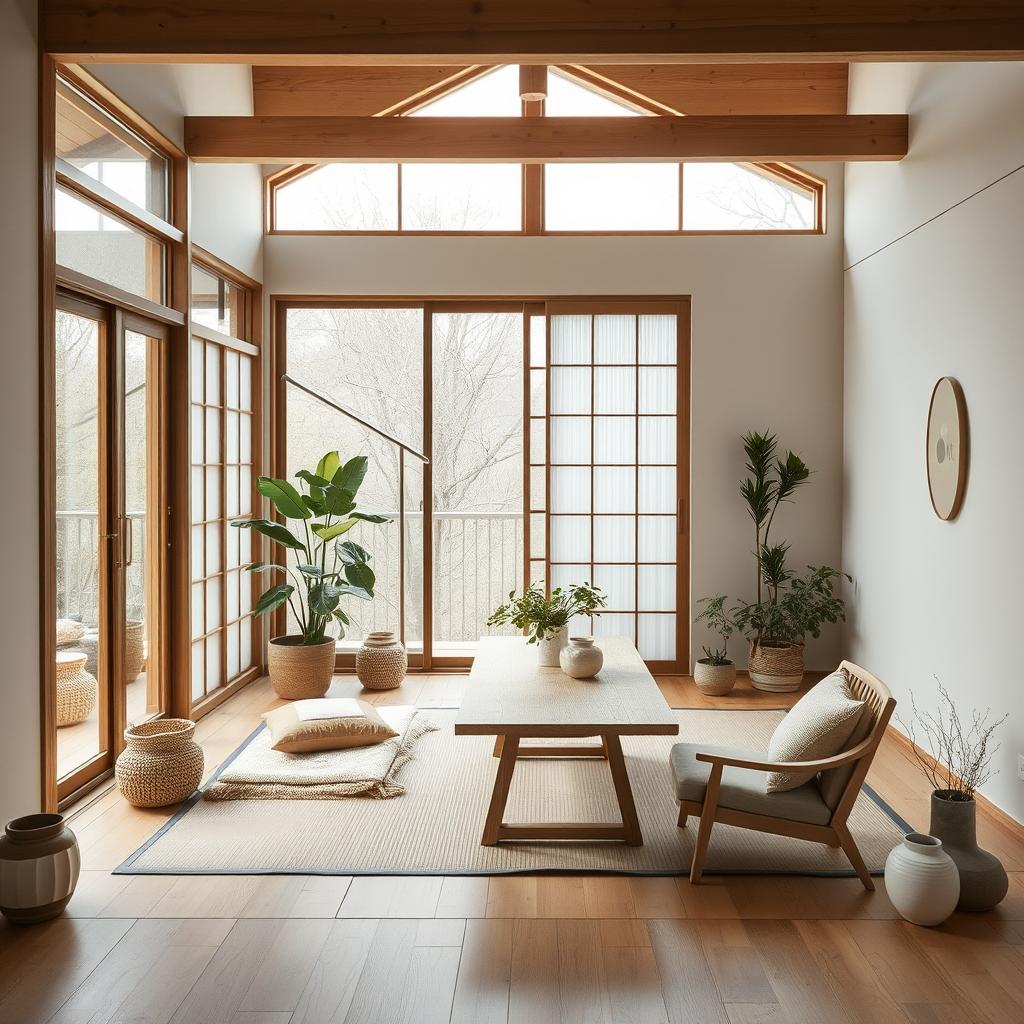
Japandi
Japandi is a design style that combines Japanese and Scandinavian aesthetics. It creates a peaceful and serene living space. This style focuses on simplicity, natural materials, and function, making homes feel calm and comfortable.
The Japandi style values finding beauty in imperfection, known as Wabi-Sabi. It matches well with Scandinavian minimalism and sustainability. This mix makes Japandi a timeless and versatile design for any room.
Japandi uses natural materials like dark wood, bamboo, and earthy tones. It blends these with modern furniture and accessories. Adding natural light, plants, and textures makes the space feel calm and connected to nature.
Japandi values simplicity, natural materials, and function. This makes Japandi a timeless and versatile design for homes and hotels worldwide.
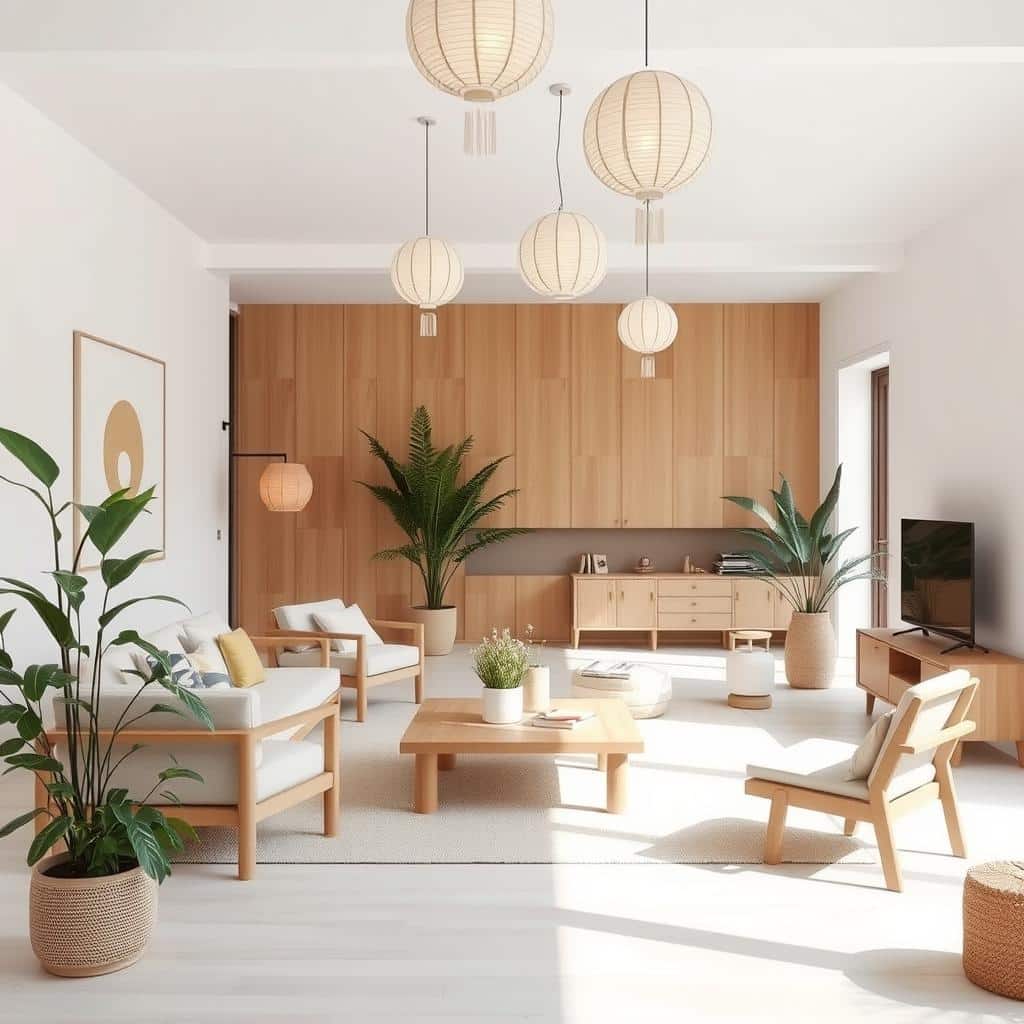
Conclusion
Japandi is a mix of Japanese and Scandinavian design, becoming very popular in interior design. It combines minimalism, natural materials, and focus on function. This creates a peaceful and harmonious living space that many people want.
The demand for sustainable and quality design is growing. Japandi fits right into this trend, making it even more popular. It’s likely to keep influencing design in the future.
Japandi offers a fresh take on modern interior design. It focuses on natural materials, clean lines, and thoughtful decor. This appeals to those who want calm and functional homes.
Designers and homeowners are drawn to Japandi’s unique approach. It shows that this blend of Japanese and Scandinavian styles will stay important in design.
In short, Japandi is a mix of two design traditions. It offers a calm and sustainable way to design homes. As people look for simple, well-made, and nature-connected spaces, Japandi will continue to grow in popularity.
FAQ
What is Japandi style?
Japandi is a mix of Japanese and Scandinavian design. It focuses on simplicity, natural elements, and comfort. This trend is popular in the U.S. for its quality, sustainability, and minimalist vibe.
What are the key principles of Japandi design?
Japandi combines Scandinavian minimalism with Japanese elegance. It values simplicity, natural materials, and craftsmanship. It also celebrates imperfection and coziness, blending Japanese wabi-sabi with Scandinavian hygge.
What are the origins of the Japandi design style?
Japandi started in the 19th century. Scandinavian designers were inspired by Japan’s craftsmanship and beauty. They merged Japanese and Scandinavian styles, creating Japandi.
What are the key characteristics of Japandi interiors?
Japandi interiors use a neutral color scheme with earthy tones. They feature natural materials like wood and stone. The focus is on minimalism, clean lines, and quality craftsmanship.
How do Japandi interiors incorporate the principles of wabi-sabi and hygge?
Japandi combines Japanese wabi-sabi with Scandinavian hygge. It uses natural materials and minimalism. This creates a calm and cozy environment.
What are the key characteristics of Japandi-style living rooms?
Japandi living rooms are calm and inviting. They have neutral sofas, wooden tables, and simple lighting. Adding plants and different textures enhances the Japandi feel.
How do Japandi-inspired bedrooms create a tranquil sanctuary?
Japandi bedrooms are peaceful retreats. They use simple colors, minimal furniture, and natural elements. This creates a calm and restful space.
What are the key features of Japandi-style bathrooms?
Japandi bathrooms are calm sanctuaries. They use natural materials and simple designs. This creates a spa-like atmosphere for relaxation.
How does the Japandi aesthetic translate to kitchen design?
Japandi kitchens are functional and simple. They use natural materials like wood and stone. Open layouts and natural light add to the calm and simplicity.
What types of Japandi decor and accessories are commonly used?
Japandi decor includes minimalist art and natural elements. These items enhance the style’s simplicity and comfort. They add to the overall harmony of the space.
Why has Japandi gained popularity in the United States?
Japandi is popular in the U.S. for its minimalist and sustainable design. It reflects a growing interest in quality and calm living spaces.
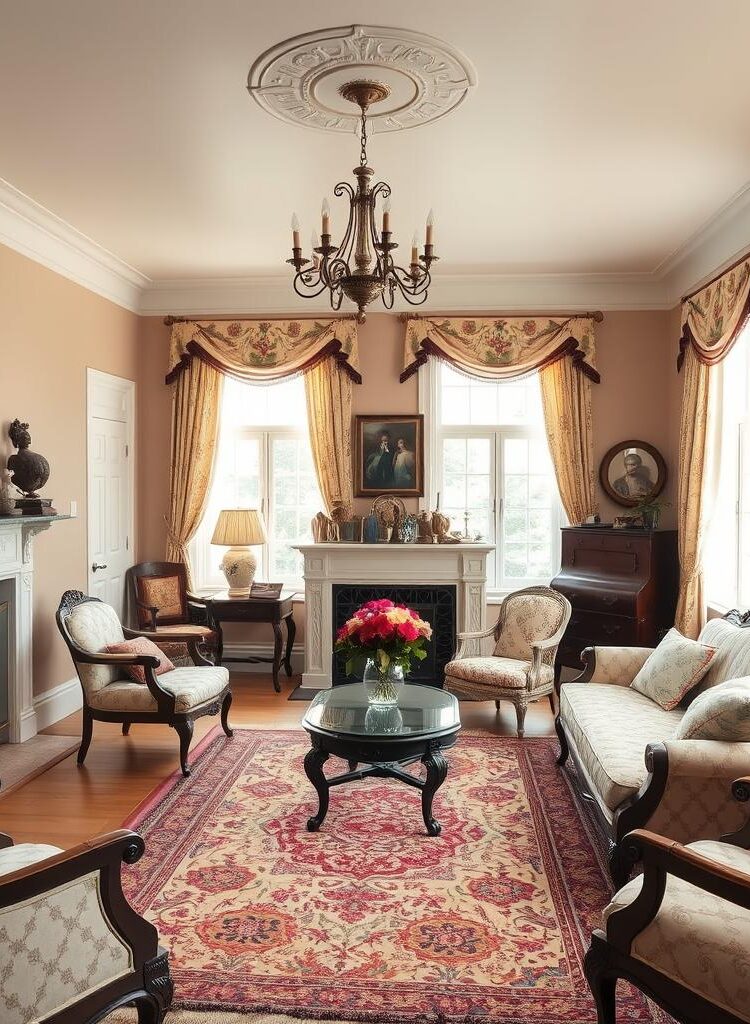
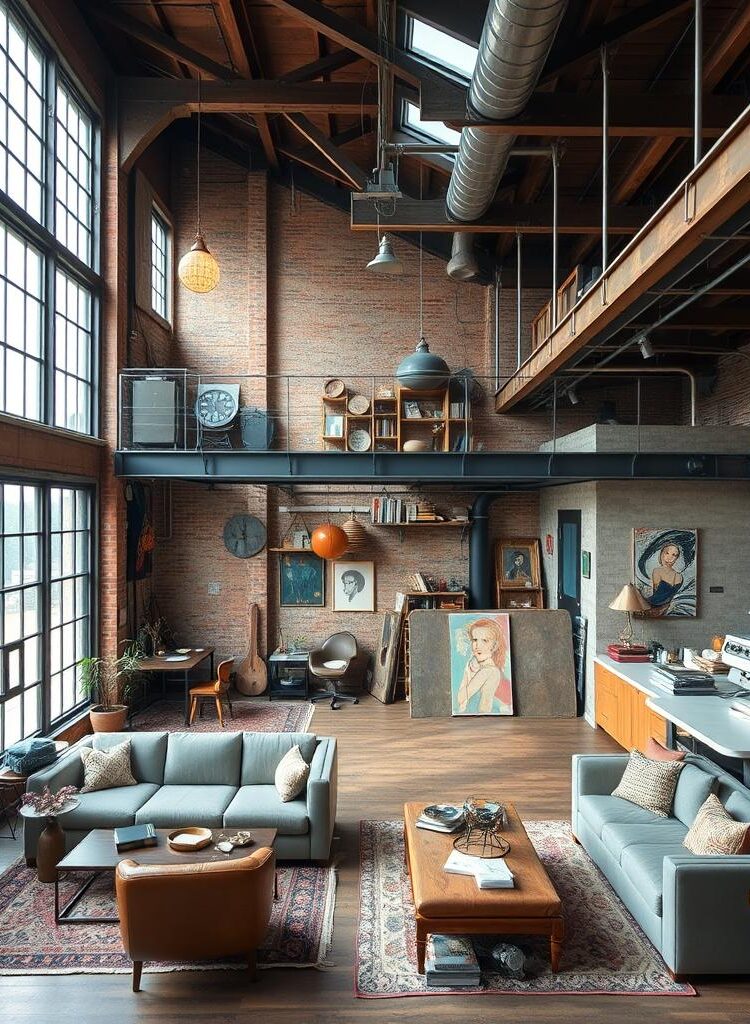
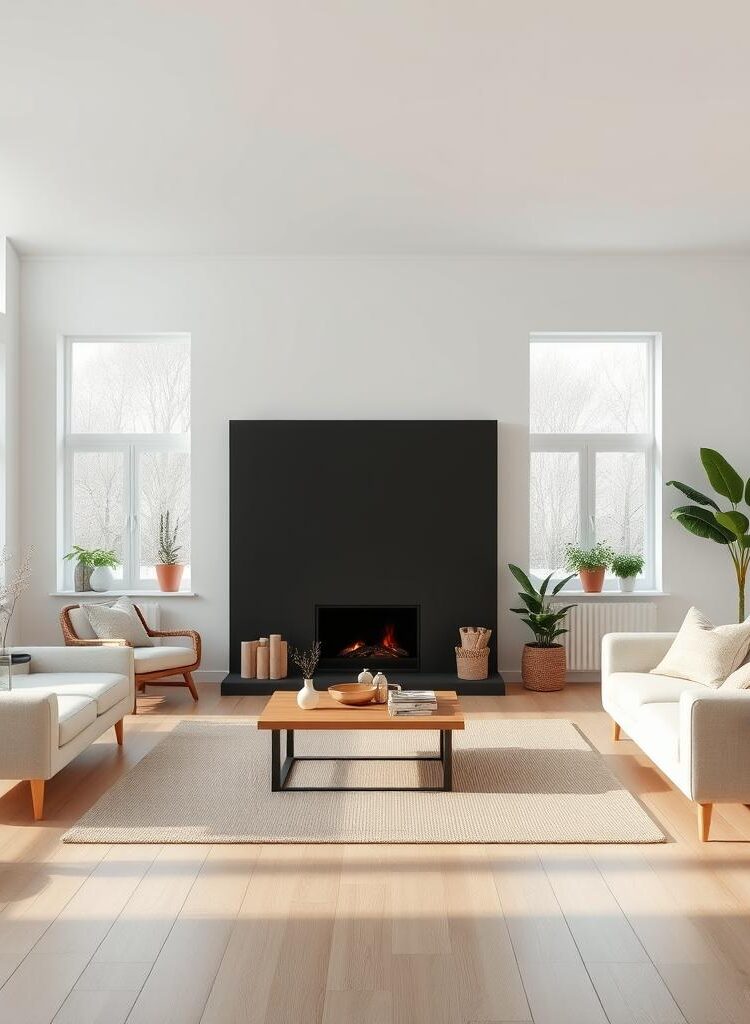

Leave a Reply